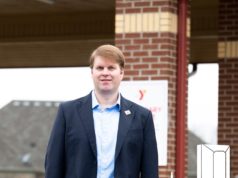“…hope and a future….â€
by Dr. Michael Mooty, Central Christian Church
[excerpted from his recent sermon outlining Central Christian Church’s role as a downtown citizen; the church is included in the recent downtown historic inventory.]
Perhaps you saw the article in yesterday’s paper about the car dealer that has built a brand new facility on Nicholasville Rd. just past Man o’ War.
Fourteen million dollars, at a time when some auto makers are closing one-third of their dealerships and auto sales have slumped to their lowest level in decades. This car dealer, is he brave? Is he visionary? Or is he foolish?
And what would you think of a church, a downtown church, that buys over three acres of land for 1.2 million dollars, and then spends more than a half a million and change to tear down a concrete nightmare just so that it can have a almost two million dollar vacant lot? (If we had not developed that land, we might have had to change our name to from Central Christian to CentrePointe Christian.) But that church, that downtown church built and remodeled, another what, six million in construction costs? Is that church brave? Is it visionary? Or is it foolish?
There are two important words here: downtown and church. When I was a student in Lexington in a early 1970s, there was nothing but downtown. Men were buying their suits at Graves Cox on Main Street, Columbia Steakhouse over on 2 St was th nd e place to eat. New Circle Road, at least on a south side, was in the country. And then, Fayette Mall changed everything. That, and the fact that a lot of graduates of our universities decided that they would rather live in Lexington than go back to Rabbit Hash. Lexington grew out. Retail left downtown. Few restaurants remained. What was left were banks and law offices and a handful of historic churches.
Now granted, the last decade has seen some encouraging signs. Condos, loft apartments, good places to eat, a new sense of partnership between city and university. But the word “downtown†still carries some liabilities for a church that, say, Reynolds Road does not. What do you think of a downtown church that decides to build?
The other important word is, of course, “church.†This is not 1894 or even 1952, the years when our forebears built this sanctuary and the old education wing. There was a time, I think, when almost everyone in Lexington went to church, or at least said they did. Churches were at the very center of community life. Over in that alcove, you will find the pulpit furniture from the old Main Street Christian Church. (That’s what this congregation called itself before it moved to Short St.. 115 yrs ago.)
That furniture was in the chancel of the Main St church in 1843 when Alexander Campbell debated a Presbyterian minister from Cincinnati named Nathan Rice, a debate moderated by the Honorable Henry Clay. The debate was about the interpretation of scripture, the historic creeds of the church, and the proper mode of Christian baptism. It was held four hours a day for sixteen days, except for the two days when Mr. Campbell and Rev. Rice carried on for six to seven hours. People came from as far away as Louisiana and New York, and the sanctuary of the Main Street church was standing room only. Can you imagine? That’s what I mean when I say that the church was at the center of the life of the community.
That, of course, is no longer the case. Going to church is no longer a social or vocational requirement. People actually decide to go to church, decide to be a Christian. Some lament the church’s loss of status. Other argue that it now means something to say: “I am a Christian.†I’ll let you decide.
The point is, we should take notice when a church decides to build. We could also add another word or two. Not only has this downtown church bought land and built, but this is a mainline church that looks traditional and, at a same time, identifies itself as progressive. Preachers wear robes. We sing out of hymnals. We have a communion table, not a drum set in a chancel. Don’t misunderstand, I celebrate a way in which many nontraditional congregations are growing. But in an era in which churches spring up on every corner like a Walgreens or Starbucks, this downtown church has a sense of history and tradition. It has roots and a deep relationship with thousands of other congregations that center their life around a table and seek the healing of the church and humankind.
Interesting isn’t it, that history and tradition can become counter-cultural. An historic, progressive, mainline, downtown church decides to buy land and to build. Is that church brave? Is it visionary? Or is it foolish?
One of my favorite stories in the Bible is found in a book of Jeremiah. Now Jeremiah was a prophet, that is, he claimed to speak on God’s behalf to the people of Israel. He lived in the late 7th and early 6th centuries before Jesus was born, and that was not a good time for a people of Israel. Little Israel sat at the crossroads of mighty empires. When Jeremiah came on a scene, Egypt and Assyria had waned but Babylon was on a rise. Jeremiah called the people to faithfulness, warned them about a coming disaster, but like most prophets, Jeremiah was carefully ignored. The army of Babylon was on the march. It came to a very gates of Jerusalem and laid siege to the city. About this time, a relative of Jeremiah’s died and he had the opportunity to purchase a field that had belonged to this relative. Now he didn’t have to buy it, and there was good reason not to.
Best I can tell, the army of Babylon, the mightiest army in a world, was camped next door to this little field with a for sale sign on it. One of Jeremiah’s relatives had already passed on the purchase, thank you very much. But Jeremiah bought the field. Not only did he buy it, he made sure that everyone saw the transaction. Signed the deed on the courthouse steps. Was Jeremiah brave? Was he visionary? Or was he foolish?
The army of Babylon, of course, ultimately captured Jerusalem. Trashed the city and destroyed the temple that Solomon had built three hundred years before. Carried all leading citizens away into captivity. Things could not have been worse for the descendants of Abraham and Sarah. Times could not have been harder. Jeremiah remained in Jerusalem, and, amidst the ruins of that once great city, wrote a letter to the exiles who had been taken away. This great prophet who had spoken words of judgment and destruction, this great prophet began to speak a different word in the face of the people’s despair. They thought that God had abandoned them, that God was nowhere to be found. And so, Jeremiah said, this is now God’s word to you: I know the plans I have for you, plans to prosper you and not to harm you, plans to give you hope and a future. You will find me when you seek me with all your heart. And of course, within a generation, the Persian empire defeated Babylon, and the people of Israel returned home.
An historic, mainline, progressive, downtown church buys a field and undertakes an ambitious building project. And wouldn’t you know, just as the project nears completion, the global economy enters a recession the likes of which most of us have never experienced. What will they say about that church. Is it brave? Is it visionary? Or is it foolish?
It all depends… It depends on whether or not we claim this field as a place where God’s children are served, where we reach out to the hungry and the homeless and the broken of spirit and say, “we care about you because God cares about you.†It depends. It depends on whether or not we spend less time worrying about our own salvation and more time praying for the healing of the nations, the healing of all creation. I believe that it is true: when we lose ourselves in love for others, we will find ourselves saved.
[excerpted from a recent sermon by Dr. Michael Mooty at downtown’s Central Christian Church. Reprinted with his permission.]
I







